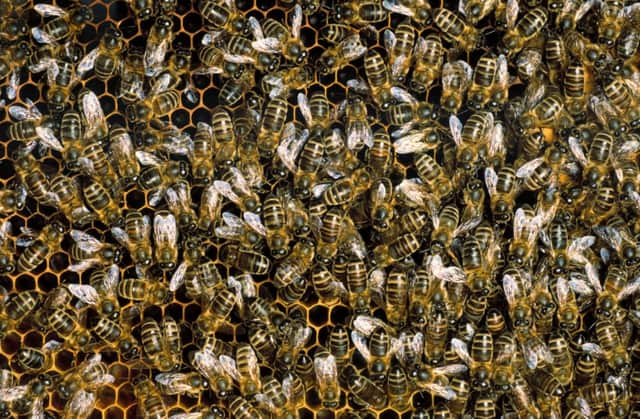Swarm of bees causes panic on Inverness street


Terrified residents ran for safety, including children who raced inside with towels on their heads, as the honey bees descended on Duke’s View cul-de-sac in the Slackbuie area of Inverness.
The buzzing insects clustered several inches thick around a For Sale sign on the street.
Advertisement
Hide AdAdvertisement
Hide AdExperts from Inverness-shire Bee Keepers Association were called in to deal with the swarm, believed to number around 30-60,000.
The incident on Friday saw them removed in three trips to the Scottish School of Forestry, three miles away in Balloch. They will be used there for training beekeepers.
Locals described the invasion as “like a whirlwind”.
Leanne Sharp, who lives in the cul-de-sac, said: “It was quite extraordinary. As I came up the street, I heard the buzzing noise but did not think anything of it.
“But then I came back up the hill and saw a big black cloud in front of my house. It was like a whirlwind of bees coming up the street. They went all the way up the street and between the houses.
“The kids in the area had to stay inside for the rest of the day, there were so many bees around.”
Neighbour Victoria Lewis, 31, was stuck in her house due to the swarm and said her husband threw towels over their children’s heads to protect them.
She said: “It was definitely not something we expected to come home to. Once the kids were inside, they did not want to come out of the house.”
Bryce Reynard of the British Beekeepers Association said a spell of warm weather triggers honey bees to start swarming.
Advertisement
Hide AdAdvertisement
Hide AdHe added: “It was an awkward place for us to collect them because the pole was about 10ft tall. If we were handling a branch it would have been easier as we can just snap it off.
“We had to move them more than three miles away from where we found them because otherwise they would just return to the same spot.
“If you don’t catch a swarm, it might go in to somewhere like a chimney or roof space and cause bigger problems.”
His colleague Julia Moran, secretary of the association, said: “There are two scenarios, either it was a wild colony from a nearby wooded area that swarmed or it was a managed colony that grew and the bee keeper did not give them a new space to be in quickly enough so they swarmed.
“When a colony gets to around 50 or 60 thousand, they quite often split and appoint a new queen and find a new place to live.
“In managed colonies, the bee keeper would deal with this by providing another wooded box to keep the new colony in.
“Swarming is what bees do in order to reproduce, to double their numbers, and happens quite often in hot summer weather.”
Councillor Ian Brown, said: “In a situation like this, the public should phone the police and they will get in touch with the bee keepers.”
Advertisement
Hide AdAdvertisement
Hide AdMeanwhile, a European honeybee that arrived in the UK just thirteen years ago is spreading like wildfire, boosting populations of the vital pollinators.
The tree bumblebee is unusual in that it nests high above ground, as its name implies, and has a distinctive light brown and black body and a white tip.
British bumblebees generally nest in holes in the ground, or on the surface in tussocky grassland.
The tree bumblebee is particularly fond of nest boxes provided for birds and has a stronger resistance to parasite infections than native bees helping it to colonize almost 4,500 square miles of land a year, about half the size of Wales.
However scientists are unsure whether the newcomers pose a threat to native bee species whose numbers are under threat from intensive agriculture, the loss of meadows and parasitic infections.
A study published in the Journal of Animal Ecology found tree bumblebees carry high levels of an infection that normally prevents queen bees from producing colonies.
Researchers collected tree bumblebee queens from the wild, checked them for parasites and then monitored colony development in a laboratory.
Despite the bees having low genetic diversity and high levels of a nematode parasite that usually castrates other species, a quarter of the queens were able to reproduce.